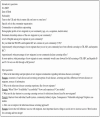Engaging new migrants in infectious disease screening: a qualitative semi-structured interview study of UK migrant community health-care leads
- PMID: 25330079
- PMCID: PMC4198109
- DOI: 10.1371/journal.pone.0108261
Engaging new migrants in infectious disease screening: a qualitative semi-structured interview study of UK migrant community health-care leads
Abstract
Migration to Europe - and in particular the UK - has risen dramatically in the past decades, with implications for public health services. Migrants have increased vulnerability to infectious diseases (70% of TB cases and 60% HIV cases are in migrants) and face multiple barriers to healthcare. There is currently considerable debate as to the optimum approach to infectious disease screening in this often hard-to-reach group, and an urgent need for innovative approaches. Little research has focused on the specific experience of new migrants, nor sought their views on ways forward. We undertook a qualitative semi-structured interview study of migrant community health-care leads representing dominant new migrant groups in London, UK, to explore their views around barriers to screening, acceptability of screening, and innovative approaches to screening for four key diseases (HIV, TB, hepatitis B, and hepatitis C). Participants unanimously agreed that current screening models are not perceived to be widely accessible to new migrant communities. Dominant barriers that discourage uptake of screening include disease-related stigma present in their own communities and services being perceived as non-migrant friendly. New migrants are likely to be disproportionately affected by these barriers, with implications for health status. Screening is certainly acceptable to new migrants, however, services need to be developed to become more community-based, proactive, and to work more closely with community organisations; findings that mirror the views of migrants and health-care providers in Europe and internationally. Awareness raising about the benefits of screening within new migrant communities is critical. One innovative approach proposed by participants is a community-based package of health screening combining all key diseases into one general health check-up, to lessen the associated stigma. Further research is needed to develop evidence-based community-focused screening models - drawing on models of best practice from other countries receiving high numbers of migrants.
Conflict of interest statement
Figures
References
-
- Rechel B, Mladovsky P, Ingleby D, Mackenbach JP, McKee M (2013) Migration and health in an increasingly diverse Europe. Lancet 381 (9873) 1235–45. - PubMed
-
- International Organization for Migration (2010) World migration report. The future of migration: building capacities for change. International Organization for Migration Available: http://publications.iom.int/bookstore/free/WMR_2010_ENGLISH.pdf. Accessed: 2014 Sept 20.
-
- European Centre for Disease Prevention and Control (2009) Migrant health: Background note to the ‘ECDC Report on migration and infectious diseases in the EU’. European Centre for Disease Prevention and Control Available: http://www.ecdc.europa.eu/en/publications/publications/0907_ter_migrant_.... Accessed: 2014 Sept 20.
-
- Hargreaves S, Friedland J (2012) Impact on and use of health services by new migrants in Europe. In: Thomas S, Gideon J, editors. Migration, Heath and Inequality. London: Zed Books. pp. 27–43.
-
- Clark RC, Mytton J (2007) Estimating infectious disease in UK asylum seekers and refugees: a systematic review of prevalence studies. J Public Health 29: 420–428. - PubMed
Publication types
MeSH terms
LinkOut - more resources
Full Text Sources
Other Literature Sources
Medical
Miscellaneous



